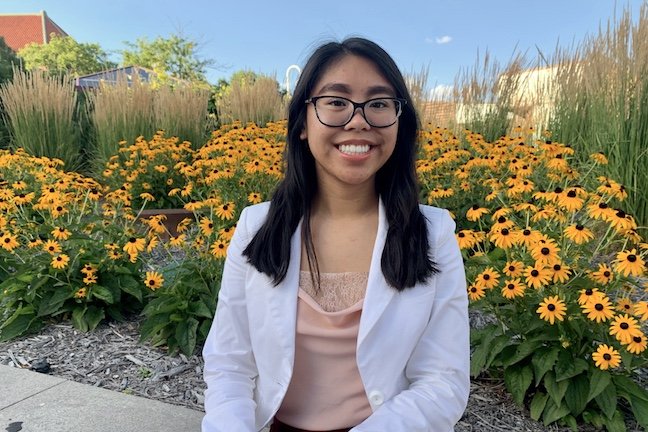Engineering to save lives

Photo credit: Steele Mitchell
CSE student eyes career in biotechnology and STEM education
August 13, 2020
Kate Fernandez had wanted to go to medical school for as long as she could remember. She wanted to use her interest in science and technology to help people, and becoming a doctor seemed like the most logical path—that is, until her mother encouraged her to look into engineering as a back-up plan.
“Through that, I got to see, ‘Oh, I can help people, but I don’t have to be a doctor,’” said Fernandez, a rising senior studying electrical engineering. “I can utilize engineering to help people, and that called to me more than directly treating patients.”
Fernandez, a recipient of the College of Science and Engineering’s 3M Diversity and Sievert Family scholarships, was inspired to attend the University of Minnesota by the late Medtronic founder Earl Bakken, a CSE alumnus who also studied electrical engineering. She hopes to follow in Bakken’s footsteps, creating more efficient medical treatments for patients through bioelectronics instead of drug prescriptions.
“One of the great things about bioelectronics is that we can get closer to fixing the problem rather than just putting a Band-Aid on it,” she said. “I like the idea of creating something that could treat something and not just treat the symptoms.”
Endless possibilities
For some students, a lab that takes 20 hours to complete might sound like a nightmare. But Fernandez enjoyed every second of EE 2361: Introduction to Microcontrollers, a class that focuses on computer coding.
“It really showed me what the possibility is for electronics, especially in application to bioelectronics,” she explained.
“It was so cool to me that I could just code something and it would do what I asked of it,” Fernandez said.
Her newfound love for microcontrollers led her to a summer internship at Miromatrix Medical, a Twin Cities biotechnology company that began as a U of M startup. Miromatrix creates bioengineered organs by stripping cells from animal organs and replacing them with cells from humans with the ultimate goal of introducing differentiated stem cells.
Fernandez is helping to revamp the company’s “recellularization” system using microcontroller technology in order to ensure the cells can be introduced to the organ scaffold's microenvironment effectively.
“People die every day waiting for an organ, so being able to increase the availability for people would just be tremendous,” she said. “Not only does quality of life usually improve with an organ transplant, but so does the longevity of that person.”
Fernandez also spent the previous summer working as a Nephrology/Urology Summer Undergraduate Research Fellow at the Mayo Clinic in her hometown of Rochester, Minn. There, she created a deep learning algorithm to identify precursors to kidney stones.
“One of the really cool things about having an internship is translating what I’ve learned in class to the field,” she said.
“One professor I have always says, ‘College classes aren’t teaching you what you need to know. They’re teaching you how to learn’," she added. "So, through taking classes, I’m able to learn better at my job.”
This fall, Fernandez will watch the majority of her lectures online because of the COVID-19 pandemic. But, most of her labs will be on campus. Considering both the risk the coronavirus poses and the benefits of in-person learning, Fernandez thinks this is the best scenario.
“Nothing can replace hands-on learning experience,” she said. “I think [the University’s] decision is really smart, and it tells me that they have their students in mind.”
Paying it forward
After she graduates in spring 2021, Fernandez plans to work toward a doctorate in biomedical engineering. Fernandez said that without her CSE scholarships, saving up for graduate school would have been more difficult.
“It’s been a dream of mine to pursue a Ph.D.,” she said.
“Being a 3M Diversity Scholarship recipient, I can put my funds toward graduate school, which would otherwise not be financially feasible for me,” Fernandez said.
Following in the footsteps of her lola, a retired English teacher, Fernandez aspires to one day become a teaching professor after she works in industry.
Fittingly, she’s involved in Department of Electrical and Computer Engineering’s Building Resources and Innovative Designs for Global Energy (BRIDGE) club, through which she’s had the opportunity to travel to a local high school and teach students about renewable energy. Fernandez also does outreach through the IEEE Women in Engineering (WIE) student group and the IEEE Honor Society.
“I went to a really good school district where we had all of these opportunities and things at our disposal. Not everyone gets that opportunity,” she said. “Being able to interact with students, especially ones that might not have access to renewable energy, and introducing them to the field of engineering—seeing their eyes light up when you tell them something and they think it’s really cool is super rewarding.”
Story by Olivia Hultgren
If you’d like to support students at the University of Minnesota College of Science and Engineering, visit our CSE Giving website.
